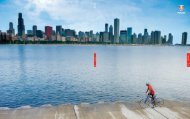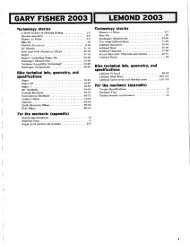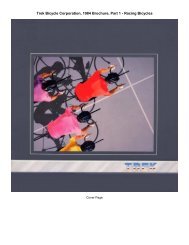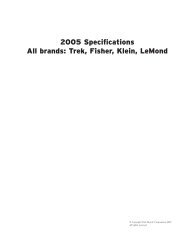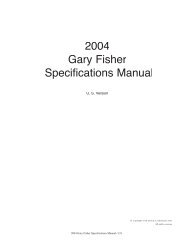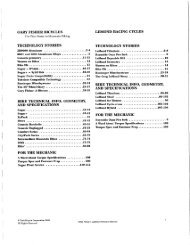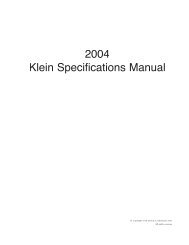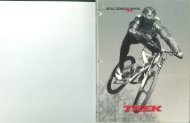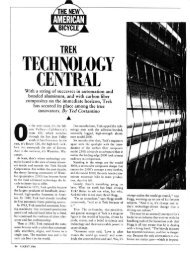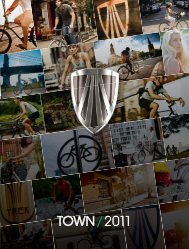TECHNOLOGY STORIES BIKE INFO, GEOMETRY ... - Vintage Trek
TECHNOLOGY STORIES BIKE INFO, GEOMETRY ... - Vintage Trek
TECHNOLOGY STORIES BIKE INFO, GEOMETRY ... - Vintage Trek
You also want an ePaper? Increase the reach of your titles
YUMPU automatically turns print PDFs into web optimized ePapers that Google loves.
124<br />
OCLV 110 Superlight Headset Service Instructions<br />
IMPORTANT NOTE BEFORE YOU BEGIN:<br />
Upper bonded<br />
insert (holds<br />
standard 11/8”<br />
Aheadset cup)<br />
Lower bonded<br />
bearing cup<br />
Fig. 23<br />
Fig. 24<br />
Standard 11/8”<br />
Aheadset cup<br />
Airhead<br />
bearing<br />
Fig. 25<br />
There are two separate head<br />
tube inserts in an OCLV 110<br />
frame (Fig. 23), the upper bonded<br />
insert and the lower bonded<br />
bearing cup. These two inserts<br />
act together like a conventional,<br />
cylindrical head tube, but at a<br />
reduced weight.<br />
The two inserts are not joined<br />
by a tube. When using a headset<br />
removal tool to remove an<br />
Aheadset cup from the upper<br />
insert, make sure the tool is<br />
inside the insert, pressing directly<br />
on the cup. It is possible to<br />
place the tool outside the insert<br />
in the space between the insert<br />
and the headlug (Fig. 24), where<br />
it will instead be pressing on<br />
the carbon fiber of the head lug.<br />
Applying force to the head lug in<br />
this way will damage the frame,<br />
and is not covered by warranty.<br />
The upper cup insert, which<br />
holds a standard 11/8” Aheadset<br />
cup, and the lower bearing cup,<br />
which holds the Airhead bearing<br />
(Fig. 25), are part of the frame.<br />
Do not attempt to remove the<br />
inserts, or you may damage the<br />
frame. Such damage is not covered<br />
by warranty.<br />
Introduction<br />
For the 2001 model year we have introduced a new<br />
OCLV road frameset, the OCLV 110 Superlight. For the<br />
2001 model year, <strong>Trek</strong> 5900s and 5700s use this new<br />
frame.<br />
The OCLV 110 frame, fork, and lower headset bearing<br />
use a proprietary system. At this time, only the supplied<br />
parts are compatible with this system. No other frame,<br />
fork, or lower headset system can be substituted for<br />
parts in this system as supplied. The upper bearing uses<br />
a standard 1 1/8” Aheadset system, from which many<br />
substitutions are available as aftermarket parts.<br />
Tools and equipment required<br />
Headset cup removal tool<br />
Headset press<br />
5900 Headset tool kit (or Klein AirHeadset tool kit)<br />
Star-fangled nut tool<br />
Metal-faced hammer<br />
Loktite RC680<br />
Loktite Kleen ‘n Prime<br />
2002 <strong>Trek</strong> Technical Manual<br />
FORK REMOVAL INSTRUCTIONS<br />
Removing the fork from the frame<br />
1. Place bike upright in a workstand,<br />
clamped by the seatpost.<br />
2. Remove the Aheadset top<br />
cap.<br />
3. Remove stem and spacers<br />
from the steerer tube.<br />
4. Remove compression washer,<br />
cone, and bearings from<br />
upper Aheadset leaving only the<br />
upper bearing cup in the upper<br />
head tube.<br />
5. Thread the star-fangled nut<br />
insertion tool into the star-fangled<br />
nut already installed in the<br />
fork steerer tube (Fig. 26).<br />
Fig. 26<br />
6. We recommend this step be<br />
done by two people. The first person<br />
should support the fork, so that it does not fall.<br />
The other person should firmly support the frame near<br />
the head tube with one hand, while hammering straight<br />
down on the star-fangled nut insertion tool. The fork is<br />
bonded in with Loktite, so it may take repeated blows to<br />
break loose the fork and bearing.<br />
7. After the fork loosens, remove the star-fangled nut<br />
insertion tool, and slide the fork from the frame.<br />
Removing the fork bearing<br />
1. Clamp the steel<br />
channel in a vise allowing<br />
enough room for<br />
the fork to be inserted<br />
from either direction.<br />
2. Thread the starfangled<br />
nut insertion<br />
tool into the star fangled<br />
nut already in the<br />
fork.<br />
Steel<br />
channel<br />
Starfangled<br />
nut insertion<br />
tool<br />
Bearing<br />
Star-fangled<br />
nut tool<br />
Fig. 27<br />
3. Carefully position the steerer in the steel channel<br />
so that the steerer rests on the channel with the bearing<br />
on the side nearest the star-fangled tool (Fig. 27).<br />
Hold the fork so it cannot fall.<br />
4. Strike the star-fangled nut insertion tool with a<br />
hammer until the bottom bearing slides off the steerer.<br />
5. Remove the fork from the steel channel.<br />
Removing upper headset cup<br />
1. With the fork removed from the head tube, the top<br />
Aheadset cup should be the only thing left in the head<br />
tube (besides the permanent bonded inserts, which are<br />
part of the frame).<br />
2. Use a headset cup removal tool to tap the top<br />
Aheadset cup out of the upper bonded insert. Make<br />
sure the tool is engaging the Aheadset cup inside the<br />
bonded insert. If the tool is outside the bonded insert,<br />
frame damage will result.<br />
3. Do not attempt to remove the lower bearing cup<br />
which holds the lower bearing. It is permanently bonded<br />
to the frame and cannot be removed.




